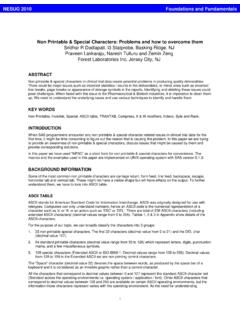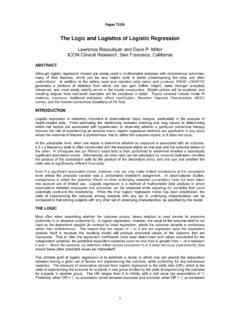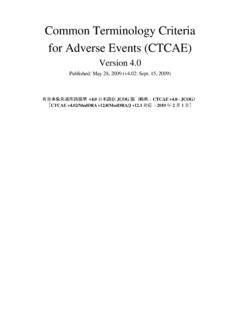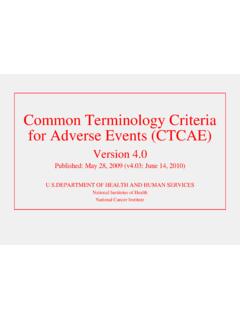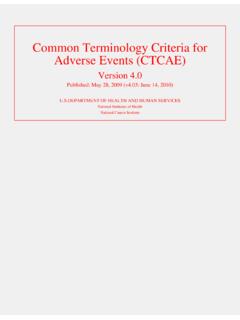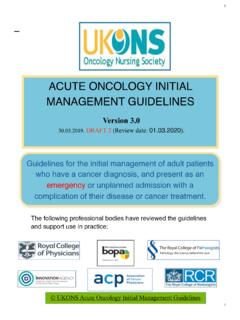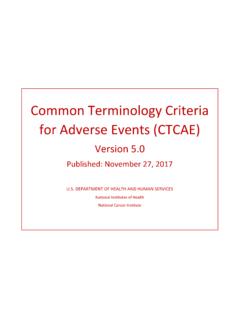Transcription of Implementing Laboratory Toxicity Grading for CTCAE Version 5
1 PharmaSUG 2019 - Paper BP-128. Implementing Laboratory Toxicity Grading for CTCAE Version 5. Keith Shusterman, Reata Pharmaceutics, Inc.;. Mario Widel, Independent Contractor ABSTRACT. Laboratory Toxicity Grading has been an important part of safety reporting since the FDA began accepting electronic data in 1999. Staying up to date with the various CTCAE versions can be a challenge. CTCAE . Version adds a layer of complexity with new Grading criteria dependent on baseline measurements. We will present a practical method for deriving Toxicity grades in the SDTM LB domain based on the new CTCAE , as well as reporting Toxicity events in an OCCDS dataset derived separately from the BDS.
2 Dataset with the Laboratory findings. INTRODUCTION. Toxicity Grading for Laboratory results began in 1999 with CTCAE Version In this Version , Toxicity Grading was based on absolute ranges relative to the upper and lower limits of normal. With these simplistic criteria, deriving the Toxicity grades was a simple task. However, the Grading criteria became more complex with the release of CTCAE Version in 2009 quickly replaced by Version in 2010. In this Version , the change in the Laboratory measurement from baseline also became a factor in deriving the Toxicity grade.
3 More interesting, however, was the introduction of the MedDRA preferred term and system organ class associated with the Toxicity . With this, it became possible to treat Laboratory Toxicity measurements as adverse events. When CTCAE Version was released in 2017, another layer of complexity was added in that the subject's status at baseline became a factor in deriving Toxicity grades. For some Laboratory measurements, the Grading is different depending on whether the subject's baseline measurement was normal or abnormal.
4 With this addition, we cannot rely solely on ranges to derive the Toxicity grade. The purpose of this paper is to demonstrate how to derive Toxicity grades with the new CTCAE criteria. Additionally, we will discuss how to leverage the MedDRA information introduced in CTCAE to represent lab toxicities as events in an ADaM OCCDS dataset. EVOLUTION IN COMPLEXITY. Consider the lab parameter Alkaline Phosphatase commonly captured in the SDTM LB domain with LBTESTCD = ALP . Abnormally high values of this parameter can result in an adverse event with the CTCAE term Alkaline phosphatase increased.
5 In CTCAE Version , Toxicity grades for this adverse event are calculated explicitly in ranges related to the upper limit of normal (ULN) as shown below in Table 1. Grade 1 Grade 2 Grade 3 Grade 4. >ULN - x ULN > - x ULN > - x ULN > x ULN. Table 1: Alkaline Phosphatase Increased Grading criteria from CTCAE Version This is very simple to program. With the result stored in LBSTRESN and the ULN stored in LBSTNRHI, one simply needs to compare the two SDTM values to determine the grade. (Note that Toxicity grade of 5.)
6 Was excluded. That grade cannot be computed based just on values in LB as it only applies when the event results in death.). Now compare this to the Alkaline phosphatase increased criteria for CTCAE Version as shown below in Table 2. 1. Grade 1 Grade 2 Grade 3 Grade 4. >ULN - x ULN if > - x ULN if baseline > - x ULN if > x ULN if baseline was baseline was normal; - was normal; > - x baseline was normal; > - normal; > x baseline if x baseline if baseline baseline if baseline was x baseline if baseline baseline was abnormal was abnormal abnormal was abnormal Table 2: Alkaline Phosphatase Increased Grading criteria from CTCAE Version In addition to LBSTRESN and LBSTNRHI from a single record as needed with CTCAE Version , we also need the LBSTRESN value from the associated baseline ALP record.
7 First, it needs to be determined whether the baseline LBSTRESN is greater than the ULN. If the baseline LBSTRESN is at or below the ULN, then the Toxicity grade is derived based on the ULN as was done in Version However, if the baseline LBSTRESN is greater than the ULN, then the grades are derived by comparing the current LBSTRESN value to the baseline LBSTRESN value instead of the ULN. (Note that the baseline records themselves are graded according to the ULN, since an abnormal baseline value cannot be compared to itself to get a meaningful grade.)
8 DERIVING THE TOXICTY GRADES. Deriving these more complex grade criteria can be frontloaded into an Excel spreadsheet and then called programmatically in a SAS macro. The Grading criteria are specified in the spreadsheet as macro variables that are then applied using a Call Execute routine. The ALP increased criteria from Version appear in the spreadsheet as shown below in Table 3. TESTCD TOX DIR G1 G2. ((&BVISN = &VISN OR &B <= &ULN) ((&BVISN = &VISN OR &B <=. Alkaline (&R > &ULN OR AND &ULN < &R <= *&ULN) OR &ULN) AND *&ULN < &R <=.))
9 ALP phosphatase &R > &B) (&B > &ULN AND 2*&B <= &R <= 5*&ULN) OR (&B > &ULN AND. increased *&B) *&B < &R <= 5*&B). Table 3: Alkaline Phosphatase Increased Grading criteria from CTCAE Version written in SAS. macro variables. (Note that Grades 3 and 4 are excluded from this display.). The macro variables are defined as follows: &R is the result from the record being graded, assumed to be captured in LBSTRESN. &ULN is the upper limit of normal, assumed to be captured in LBSTNRHI. &VISN is the visit number of the record being graded, captured in VISITNUM.
10 &B is the baseline result found in LBSTRESN of the associated baseline record. &BVISN is the baseline visit number found in VISITNUM of the associated baseline record. The DIR column specifies a Grading direction. In this case, the direction criterion is met if the result is greater than the ULN or the baseline result. While only increases are relevant for this specific test, specifying directionality is necessary as there are lab tests that need to have grades assigned based on both increases and decreases. (An example of bidirectional Grading will be provided later.)






